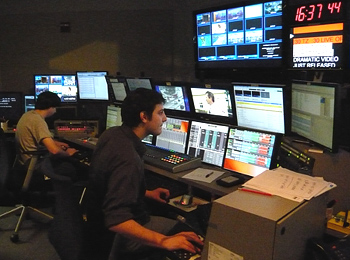News Automation: Ready for Primetime?
DALLAS We're surrounded with juicy news stories begging for coverage, yet traditional media—print and broadcast—are cutting corners and staff to stay afloat, victims of a double-whammy: The economy and shrinking audiences. A December Pew Research survey reported the Internet now rivals television as the main news source for nearly six-in-10 Americans under 30; newspapers fell behind the net in all age groups.
The challenge for broadcasters is to be relevant in a media-saturated, "I want it now" world. Automation may offer the best lifeline to sinking newsrooms by enabling on-air consistency, cost-efficient workflows and greater freedom to focus on content.
But isn't news too dynamic and in-the-moment to automate? Not according to Frank Tomaszewski, director of technology for NBC Universal's local media division: "Automated systems are ready for primetime and we've proven that with many great newscasts in top markets. [They] perform well during breaking news situations; you have access to all of your sources right at your fingertips."

Raycom's WMC-TV in Memphis, Tenn., uses Bitcentral's platform to automate its news production.QUEUE AND PLAY
Scott Blair, newsroom automation product manager for Avid Technology, views automation as a positive force, "...it can do more than reduce headcount; it lets people be more productive. Allowing automation to queue and play graphics and clips frees people from control room duty to create fresh content for up-coming newscasts."
Avid Tech-nology's Com-mand is an on-air news "automation assist," with interfaces to newsroom computer systems and control over Avid servers, graphics and still/clip-stores. Command's playlist interacts with ENPS and iNews, "so changes are reflected in the rundown as they're made," Blair said. "It also displays what's loaded, what's queued, and depending on the device, thumbnails on the director's screen," he added. And Command can stack elements without a newsroom system, Blair noted. "The user simply builds a playlist of clips to execute on demand."
Recognizing the growing importance of alternative formats, Avid recently released Active Content Manager 3.0 to raise stations' Web/mobile presence with reformatted audio, video and graphics. And the company recently announced that it had declared a détente in its NRCS rivalry with AP, pledging to boost cooperation and testing of MOS integration workflows.
FIELD-CENTRIC
Bitcentral's "no barriers" workflow employs the Internet and cellular broadband to capture and deliver news. "Many customers, like KRON in San Francisco, have been editing and submitting stories from places like Starbucks," said Bitcentral President Fred Fourcher. "Stations are running on a model that hasn't changed much since the 1970s; we define a workflow that starts in the field because that's where news happens. A field-centric process is far more efficient than microwave trucks or bringing journalists to the station to submit stories.
"If your only product's the 5:00 news, you're screwed," Fourcher continued. "It's important to have compelling local content and distribute to platforms that make revenue."

Andrew Brooks (L), Ignite associate director and Alex Lari, Ignire Director, set up an Ignite system at WHTV in Orlando, Fla. Bitcentral offers Précis, an end-to-end digital workflow, play-to-air, and news management solution; AirNow! to stream live news via cellular networks; and Oasis for distribution and archiving. Précis can ingest multiple SD, SDI and HD sources and enables journalists to gather, edit, and submit remotely. And it facilitates repurposing for multiple platforms. AirNow! "...can provide coverage that isn't possible with live trucks, such as an interview from a high rise building or a live camera in an area too dangerous for people," said Fourcher.
Oasis uses commodity storage for cost-efficient sharing over existing bandwidth between stations across a region or the country. Producers view proxies and can request an entire clip or specific segments be sent to their location. "Producers are so dependent on Oasis, losing it would be like taking Google away," said Fourcher.
Raycom is among several groups to adopt Bitcentral's model. "We decided a number of years ago to move our extensive local news operations to a file-based workflow for easy collaboration and sharing of assets. This allowed us to easily share content between our contiguous markets. Bitcentral provided a number of solutions to help us realize that concept, both at the station and enterprise level" said Dave Folsom, vice president of technology for Raycom. "We have the number one news operation in just about every one of our markets. File-based workflow allows us to feed three screens, air, Web and mobile, 24x7 without increasing costs, while making more productive use of personnel."
STREAMLINING FUNCTIONS
Digital Broadcast's NewsBank is an integrated, networked news production, ingest, editing, on-air delivery and content management system.
"NewsBank streamlines journalists' functions," said Ann Meredith, vice president of marketing for Digital Broadcast in Gainesville, Fla. Using the company's own hardware, it interfaces with the usual NRCS suspects, news sources and editors. The HD version up/down-converts for simultaneous HD/SD play-out, enabling smaller markets, such as KVEO in Brownsville, Texas and WFFF in Burlington, Vt., to offer high-definition news.
Interconnected NewsBank sites can view and share content, as several Communications Corporation (ComCorp) of America stations do daily as "Fox News Louisiana."
"Servers in Baton Rouge, Lafayette, Alexandria and Shreveport are synchronized and linked with two-way fiber. Broadcasts at one location are aired live in the other markets, which insert their local news, weather and sports," said Meredith. In addition, NewsBank's portable workstations let journalists edit and transmit stories from the field. MediaVault, NewsBank's archiving companion, is a Blu-Ray robot with high-speed browser that indexes script and video metadata.
ON THE FLY
Ross Video's OverDrive is an integrated system combining switcher, automation, NRCS connectivity and MOS controls. Brad Rochon, marketing product manager, attributes its popularity to reliable client/server architecture, ability to handle unscripted changes, and wide-ranging MOS device workflow.
"Operators can control devices and monitor, edit or manage rundowns from one or many locations... a huge advantage for facilities looking to squeeze every last drop of efficiency from their workflow," he said. "No less important is the ability for a news team to make changes on-the-fly with full knowledge that the OverDrive operator will instantly see and take that content to air, letting facilities take full advantage of late breaking news and unscripted events."
LiveLink, Over-Drive's MOS connection to newsroom systems, directly controls the rundown and embeds production elements such as switches, DVE effects, audio mixes and camera moves. "Over-Drive integrates with over 100 devices from leading vendors," Rochon said.
WCAU, Philadelphia's NBC O&O, used OverDrive for end-to-end election coverage and the Obama victory celebration. At the opposite end of the DMA scale, WWNY, Watertown, NY's CBS outlet has been "operating successfully with OverDrive for about a year," said John Seymour, director of broadcast operations for WWNY. "Ross' design, integrating OverDrive with their switcher adds another layer of redundancy and in broadcasting redundancy is essential."
REPEATABILITY
Grass Valley's Ignite is a single-operator centralized control solution with internal video switcher and audio mixer. Alex Holtz, director, integrated production solutions for Grass Valley, identified three market forces driving Ignite sales: "The requirement to produce more efficiently due to advertising erosion, the economic downturn, and new media competition; the need to produce for the Web and mobile devices faster, with higher throughput; and, due to media consolidation, acquire tools that allow [operators] to mark, pre-plan, and produce content in a single workflow that addresses over-the-air, Web and mobile."
"And do it with a minimum number of bodies," added John Benson, senior product manager for Grass Valley. Ignite streamlines the breaking news production process, Benson said.
"Stations have told us they're able to do breaking news and get it on-air faster and cleaner than in the past," he said.
WFTV, a Cox-owned ABC affiliate in Orlando, Fla., proved the point with their extended reporting of the Caylee Anthony disappearance.
"We did lots of breaking news and wall-to-wall coverage, all using Ignite. Our ratings, and the quality of our newscast, held up during the transition into the Ignite world," said John Demshock, director of engineering for the station. "Repeatability is an Ignite strong point; once they get it in, it clicks off the same way every time. I don't think we could get anyone to go back. Producers especially like the system because of its late breaking news macros; those are all very repeatable."
WFTV just purchased Grass Valley's MediaFUSE to help streamline and add more video to the station's Web product. Introduced at the 2008 NAB Show, MediaFUSE provides an automated toolkit for simultaneous Web, mobile, and IPTV production. It bridges the gap between "the broadcasters' schedule model and the Web's on-demand model," said Benson. And it "addresses the sales and reconciliation process through BXF feedback to the master traffic system," Holtz added.
What's next? Broadcast news isn't going away anytime soon. Fourcher, a telecom veteran, anticipates "a massive consolidation at some point; we're not going to see six to eight players in a market doing news, with newspapers and television all independently covering stories." The dilemma for broadcasters is how to satisfy the public's craving for "anytime, anywhere" content while maintaining brand relevance. Technology can help, but it's only part of the solution.
Get the TV Tech Newsletter
The professional video industry's #1 source for news, trends and product and tech information. Sign up below.
